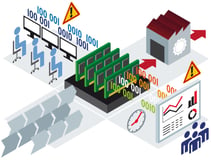How to Fight Off Transport Logistics Delays
Jesse Kelber - August 25, 2020

 There are few certainties in logistics. What there are plenty of, however, are variables. And those variables can lead to disruptions and delays. Whether it’s a freak storm wreaking havoc on shipping lanes in the Atlantic or an upstream partner having sourcing problems with your raw materials—delays and disruptions are some of the only certainties in this often volatile leg of the global supply chain. Delays can be broken down into two broad categories: the ones caused by unforeseeable events (like the storm mentioned above) and those caused by human error, lack of planning, or siloed information. In other words, there are delays you can’t do anything about in advance, and there are delays you absolutely can do something about in advance. It’s these latter disruptions we’d like to address today with some suggestions for how to fend off delays in your transport logistics.
There are few certainties in logistics. What there are plenty of, however, are variables. And those variables can lead to disruptions and delays. Whether it’s a freak storm wreaking havoc on shipping lanes in the Atlantic or an upstream partner having sourcing problems with your raw materials—delays and disruptions are some of the only certainties in this often volatile leg of the global supply chain. Delays can be broken down into two broad categories: the ones caused by unforeseeable events (like the storm mentioned above) and those caused by human error, lack of planning, or siloed information. In other words, there are delays you can’t do anything about in advance, and there are delays you absolutely can do something about in advance. It’s these latter disruptions we’d like to address today with some suggestions for how to fend off delays in your transport logistics.
Fight Logistics Delays with Supply Chain Visibility
End-to-end supply chain visibility is a goal every supply chain manager and logistics planner is striving for. We all know it’s the key to a streamlined, accurate, and efficient value chain, but have you stopped to look at any individual piece of the puzzle that is supply chain visibility? It’s not always clear cut just what is involved or what the specific benefits are to each stage of the transformation. When it comes to logistics delays, in particular, there are a couple of methods for achieving the visibility you need to eliminate the most delays possible and mitigate the impact of the rest. We’re talking about digital twins, cloud-based SCM solutions, and working effectively with shadow IT.
Digital twins for logistics
Gartner defines a digital twin as “a digital representation of a real-world entity or system.” They go on to say that it is a discrete software object or model that mirrors a real-world system or process. Uses for digital twins have been expanding up and down the supply chain for several years already, but we’ll focus on their impact on transport logistics today. By creating a computerized model of your logistics network, you can spot the precise location of a bottleneck at the dock. You’re able to see, in real-time, how a shift to your truck’s routing can save time and money. And you’re able to collect data from disparate systems like on-board computers in your trucks, IoT sensors at the plant, and RFID trackers in your warehouse in one centralized location so all stakeholders have equal access to the data they need.
SCM in the cloud and Shadow IT
Digital twins truly shine when you host them in the cloud. This is the best possible scenario because a centralized, accessible location like a cloud solution allows complete access to all partners while giving you sole control over that access and over how the collected data is used. To effectively eliminate data silos and identify access constraints, a cloud SCM solution is an excellent place to start. A move to the cloud will also help daylight instances of shadow IT. Shadow IT is defined as any IT asset not under the oversight of your IT department. So when your fleet manager has a standalone tracking app on his tablet that doesn’t report into the main SCM tool, that’s shadow IT. There are two options for working with these situations, you can embrace them by bringing the tool being used into the fold, or you can eliminate it by ensuring everyone gets the tools they need from IT in the first place. Either way, using a centralized SCM solution in the cloud is a fantastic way to make progress on eliminating the silos and data gaps shadow IT causes.
Fight Logistics Delays with Data
By now we hope you understand the crucial nature of accurate data in keeping your network operating smoothly and ensuring deliveries are made on-time and on-budget. What might not be as clear is that data has to be up-to-date in order to be effective. Relying on outdated information can be just as bad as, or worse than, operating with no data at all and relying on the planners’ intuition to carry your deliveries through. Connecting every other tactic we’re going into today, the data stream is what powers business, and by extension successful transport logistics. A sensible deployment of IoT devices, RFID chips, and other Industry 4.0 technology throughout your supply chain will supply you with ample data to form a sturdy foundation for your logistics planning.
Fight Logistics Delays with Advanced Analytics
All the data in the world won’t help your trucks arrive on time if you can’t glean actionable insights from it. This is where advanced analytics steps in. The more data your IoT devices are generating, the more you need an analytics engine that can keep up, providing you with the real-time insights necessary to reroute those trucks and keep your shipments moving around the inevitable disruption or two. Advanced analytics come in many flavors, but when it comes to logistics planning we see two as standing out: predictive and prescriptive analytics. It’s in the combination of the two that you will find those insights. Combining historical traffic flow patterns with driver habits and current conditions produces optimized routing while the ability to conduct pre-planned maintenance based on workload eliminates unscheduled breakdowns.
Predictive analytics tells you what should happen next. So if you feed historical traffic flow patterns for your shipping hub region into the engine, what you’ll get is a prediction of what traffic will look like for the coming days (or months, etc). For forecasting accuracy, nothing beats predictive analytics. And that’s where prescriptive analytics enters the picture. Prescriptive is the best word for this class of analysis as it is designed to tell you precisely what you should do about the results of your predictive analysis. Do you need to reroute shipment A to avoid roadworks? Or use a different 3PL for shipment B due to a strike in their home region? Prescriptive analytics will give you the data to make informed decisions.
LATEST POSTS
- Understand Why Production Planning Needs Specialized Solutions
- Understand Circular Economy in The Manufacturing Industry
- How Can Industry 4.0 IT Integration Be Achieved Smoothly?
- The Significance of Order Sequencing in Discrete Manufacturing
- How to improve your Supply Chain Management: The Power of Control Towers



